MCAT Biochemistry - Lipid and Amino Acid Metabolism
1/58
Earn XP
Description and Tags
594
Name | Mastery | Learn | Test | Matching | Spaced |
|---|
No study sessions yet.
59 Terms
Dietary fat
consists mainly of triacylglycerols, with the remainder comprised of cholesterol, cholesteryl esters, phospholipids, and free fatty acids
Lipid digestion
minimal in the mouth and stomach; mostly occurs in small intestine
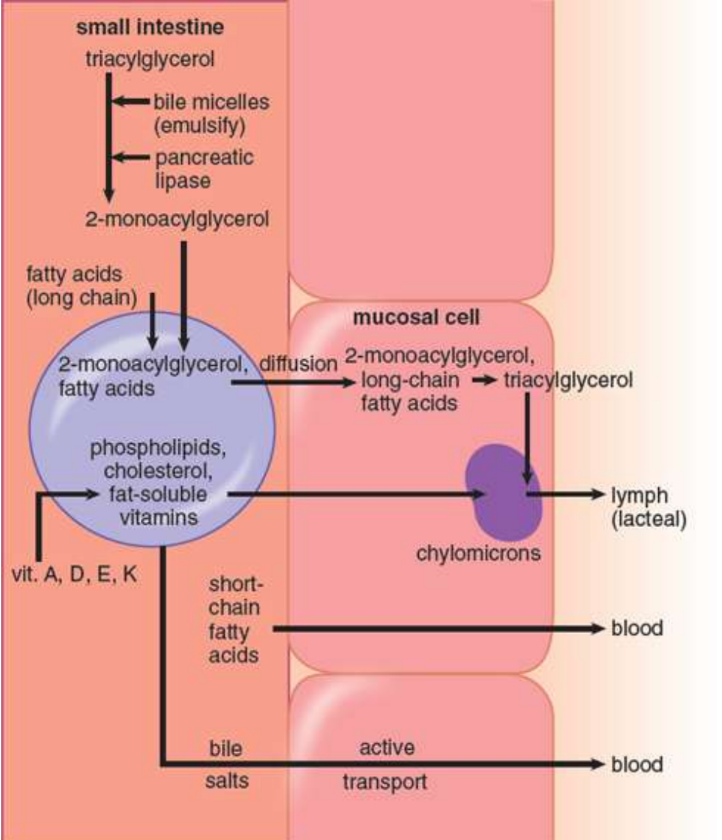
emulsification
mixing of two normally immiscible liquids; increases the surface area of the lipid, which permits greater enzymatic interaction and processing; aided by bile
bile
contains bile salts, pigments, and cholesterol; secreted by the liver and stored in the gallbladder
pancreas
secretes pancreatic lipase, colipase, and cholesterol esterase that hydrolyze the lipid components to 2-monoacylglycerol, free fatty acids, and cholesterol
micelles
clusters of amphipathic lipids that are soluble in the aqueous environment of the intestinal lumen; vital in digestion, transport, and absorption of lipid-soluble substances starting from the duodenum all the way to the end of the ileum
chylomicrons
lipoproteins; transport dietary triacylglycerols, cholesterol, and cholesteryl esters from intestine to tissues; highly soluble in both lymphatic fluid and blood; assembly occurs in intestinal lining
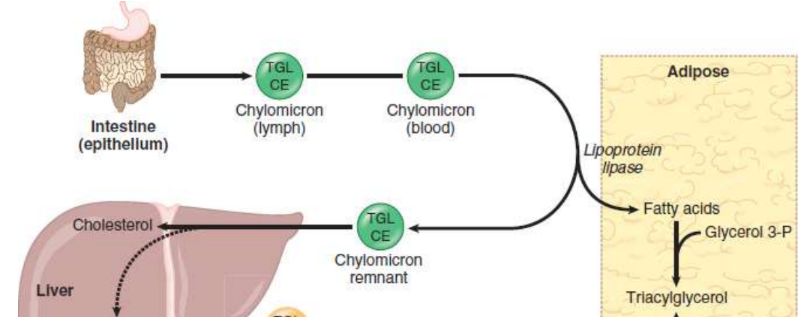
lacteals
vessels of the lymphatic system
thoracic duct
long lymphatic vessel that empties into the left subclavian vein at the base of the neck
hormone-sensitive lipase (HSL)
hydrolyzes triacylglycerols yielding fatty acids and glycerol in adipose tissues
activated by fall in insulin levels, epinephrine, cortisol

lipoprotein lipase (LPL)
necessary for the metabolism of chylomicrons and very-low-density lipoproteins; enzyme that can release free fatty acids from triacylglycerols in these lipoproteins
postabsorptive state
utilizing energy stores instead of food for fuel
albumin
carrier protein responsible for free fatty acid transport in blood
lipoproteins
Biochemical assembly whose purpose is to transport hydrophobic lipid molecules; named according to their density proportionate to the percentage of protein

apolipoproteins / apoproteins
proteins that bind lipids to form lipoproteins; receptor molecules and are involved in signaling
types of apolipoproteins
apoA-I: activates LCAT, an enzyme that catalyzes cholesterol esterification
apoB-48: mediates chylomicron secretion
apoB-100: permits uptake of LDL by the liver
apoC-II: activates lipoprotein lipase
apoE: permits uptake of chylomicron remnants and VLDL by the liver
very low density lipoproteins (VLDL)
Transports triacylglycerols and fatty acids from liver to tissues; produced and assembled in liver cells; contain fatty acids that are synthesized from excess glucose or retrieved from chylomicron remnants

intermediate density lipoproteins (IDL, VLDL remnant)
when triacylglycerol is removed from VLDL; picks up cholesteryl esters from HDL to become LDL; reabsorbed by the liver by apolipoproteins on its exterior or further processed in the bloodstream; transition particle between triacylglycerol transport (associated with chylomicrons and VLDL) and cholesterol transport (associated with LDL and HDL)
low density lipoproteins (LDL)
Delivers cholesterol into cells for biosynthesis; cholesterol measured in blood
high density lipoproteins (HDL)
Picks up cholesterol accumulating in blood vessels; Delivers cholesterol to liver and steroidogenic tissues; Transfers apolipoproteins to other lipoproteins; synthesized in the liver and intestines and released as dense, protein- rich particles into the blood
Cholesterol
ubiquitous component of all cells in the human body; plays a major role in the synthesis of cell membranes, steroid hormones, bile acids, and vitamin D; derived from LDL or HDL or synthesised de novo
De novo synthesis of cholesterol
occurs in liver and is driven by acetyl-CoA and ATP
citrate shuttle carries mitochondrial acetyl-CoA into the cytoplasm, where synthesis occurs
NADPH supplies reducing equivalents
Synthesis of mevalonic acid in the smooth endoplasmic reticulum (SER) by 3-hydroxy-3-methylglutaryl (HMG) CoA reductase = rate-limiting step
inhibited by cholesterol
promoted by insulin and HMG-CoA reductase gene expression
Lecithin–cholesterol acyltransferase (LCAT)
enzyme found in the bloodstream that is activated by HDL apoproteins; adds a fatty acid to cholesterol produces soluble cholesteryl esters such as those in HDL
cholesteryl ester transfer protein (CETP)
HDL cholesteryl esters can be distributed to other lipoproteins like IDL, which becomes LDL by acquiring these cholesteryl esters
Fatty acids
long-chain carboxylic acids
carbons:double bonds
Saturated fatty acids
no double bonds; generally cis configuration
unsaturated fatty acids
one or more double bonds; largely essential
α-linolenic acid & linoleic acid
polyunsaturated fatty acids; important in maintaining cell membrane fluidity
omega (ω) numbering system
describes the position of the last double bond relative to the end of the chain and identifies the major precursor fatty acid
nontemplate synthesis
do not rely directly on the coding of a nucleic acid
Palmitic acid (palmitate)
primary end product of fatty acid synthesis
Fatty acid biosynthesis
occurs in the liver and occassionally in adipose tissue; products are subsequently transported to adipose tissue for storage; acetyl-CoA carboxylase and fatty acid synthase
stimulated by insulin
pyruvate dehydrogenase complex
produces Acetyl-CoA → couples with oxaloacetate to form citrate
citrate shuffle
moves citrate from inside mitochondria to cytoplasm
citrate lyase
splits citrate back into acetyl-CoA and oxaloacetate (returns to the mitochondrion to continue moving acetyl-CoA)
Acetyl-CoA carboxylase
activated in the cytoplasm for incorporation into fatty acids; rate-limiting enzyme of fatty acid biosynthesis; adds CO2 to acetyl-CoA to form malonyl-CoA
requires biotin and ATP
activated by insulin and citrate
Fatty acid / palmitate synthase
large multienzyme complex found in the cytosol; contains an acyl carrier protein (ACP); Eight acetyl-CoA groups are required; may then be elongated and desaturated, to a limited extent, using enzymes associated with the smooth endoplasmic reticulum
requires pantothenic acid (vitamin B5) and NADPH
activated by insulin
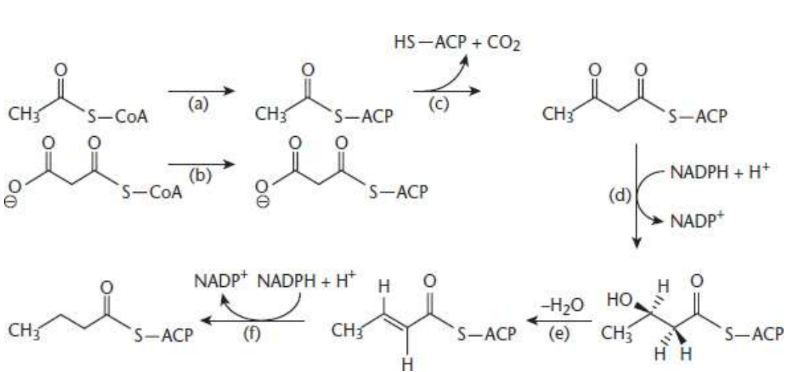
palmitate (16:0)
only fatty acid that humans can synthesize de novo.
Triacylglycerol (Triglyceride) Synthesis
the storage form of fatty acids; formed by attaching three fatty acids (as fatty acyl-CoA) to glycerol; primarily occurs in the liver
β-oxidation
Most fatty acid catabolism in the mitochondria; can be peroxisomal; reverses the process of fatty acid synthesis by oxidizing and releasing molecules of acetyl-CoA
inhibited by insulin
stimulated by glucagon
Steps of β-oxidation
Oxidation of the fatty acid to form a double bond
Hydration of the double bond to form a hydroxyl group
Oxidation of the hydroxyl group to form a carbonyl (β-ketoacid)
Splitting of the β-ketoacid into a shorter acyl-CoA and acetyl-CoA
continues until the chain has been shortened to two carbons, creating a final acetyl-CoA
odd numbers: odd-numbered fatty acids yield one acetyl- CoA and one propionyl-CoA → may eventually go on to make glucose
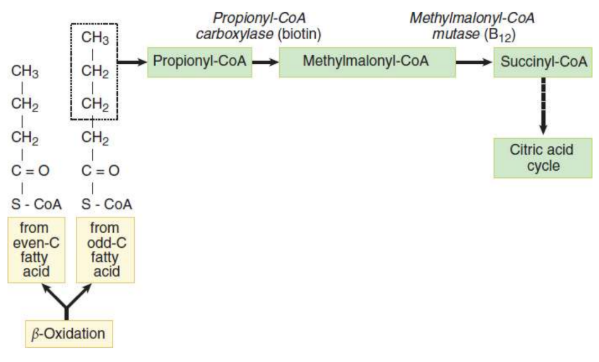
α-oxidation
catabolism of branched-chain fatty acids
ω-oxidation
in the endoplasmic reticulum; produces dicarboxylic acids
fatty-acyl-CoA synthetase
attaches fatty acids to CoA for metabolism → fatty acyl-CoA or acyl-CoA
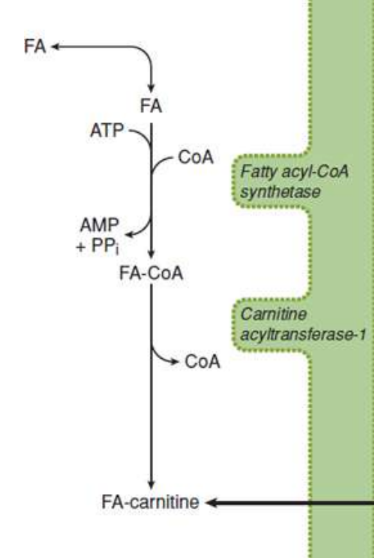
Carnitine acyltransferase I
rate-limiting enzyme of fatty acid oxidation; transports long-chain fatty acids (14 to 20 carbons) into mitochondria (smaller chains diffuse freely)

propionyl-CoA carboxylase
Propionyl-CoA is converted to methylmalonyl-CoA
requires biotin (vitamin B7)
methylmalonyl-CoA mutase
Methylmalonyl-CoA is converted into succinyl-CoA; citric acid cycle intermediate and can also be converted to malate to enter the gluconeogenic pathway in the cytosol
requires cobalamin (vitamin B12)
Enoyl-CoA isomerase
rearranges cis double bonds at the 3,4 position to trans double bonds at the 2,3 position once enough acetyl-CoA has been liberated to isolate the double bond within the first three carbons; permits β-oxidation to proceed in monounstaurated fatty acids
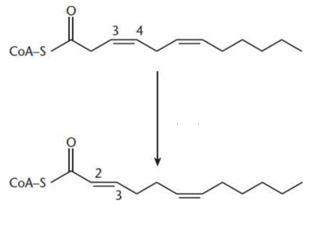
2,4-dienoyl-CoA reductase
convert two conjugated double bonds to just one double bond at the 3,4 position, to form a trans 2,3 double bond in polyunsaturated fatty acids
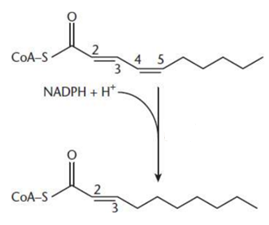
ketone bodies
water-soluble molecules or compounds that contain the ketone groups produced from fatty acids by the liver; readily transported into tissues outside the liver, where they are converted into acetyl-CoA which then enters the citric acid cycle and is oxidized for energy
ex. acetoacetate and 3-hydroxybutyrate (β-hydroxybutyrate)
tissues that can use ketone bodies
Cardiac and skeletal muscle and the renal cortex; muscles during fasting (as fast as liver can produce, prevent accumulation), one week fasting - brain
Ketogenesis
production of ketone bodies; occurs in the mitochondria of liver cells when excess acetyl- CoA accumulates in the fasting state
HMG-CoA synthase
forms HMG-CoA
HMG-CoA lyase
breaks down HMG-CoA into acetoacetate, which can subsequently be reduced to 3-hydroxybutyrate; acetone is a minor side product that is formed but will not be used as energy
succinyl-CoA acetoacetyl-CoA transferase (thiophorase)
Acetoacetate picked up from the blood is oxidized to acetoacetyl-CoA in the mitochondria; enzyme absent in liver
Ketolysis
use of ketone bodies for energy; when ketones are metabolized to acetyl-CoA, pyruvate dehydrogenase is inhibited - spares essential protein from being metabolised into glucose
Proteolysis
breakdown of proteins; begins in the stomach with pepsin, continues with the pancreatic proteases trypsin, chymotrypsin, and carboxypeptidases A and B, completed by the small intestinal brush-border enzymes dipeptidase and aminopeptidase; → amino acids, dipeptides, and tripeptides that are absorbed through the luminal membrane by secondary active transport linked to sodium

urea cycle
amino groups removed by transamination or deamination constitute a potential toxin to the body in the form of ammonia; occurs in the liver

amino acid side chain metabolism
Basic amino acid side chains feed into the urea cycle
other side chains act like the carbon skeleton and produce energy through gluconeogenesis or ketone production